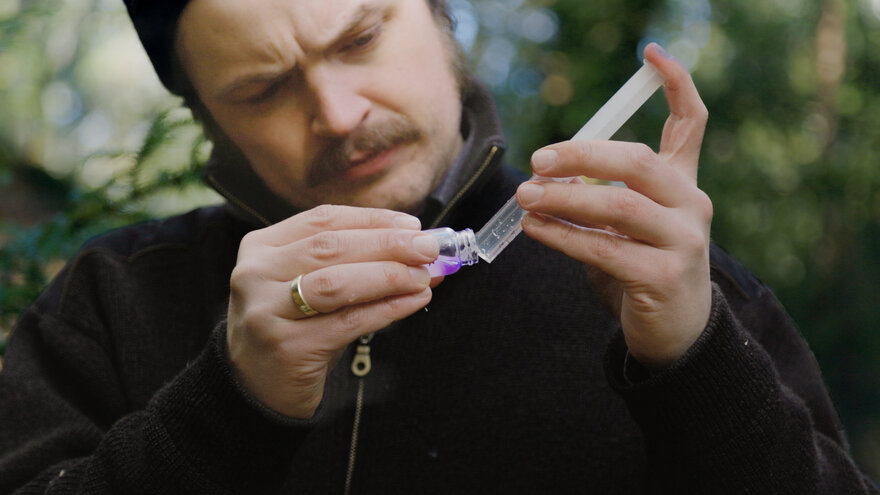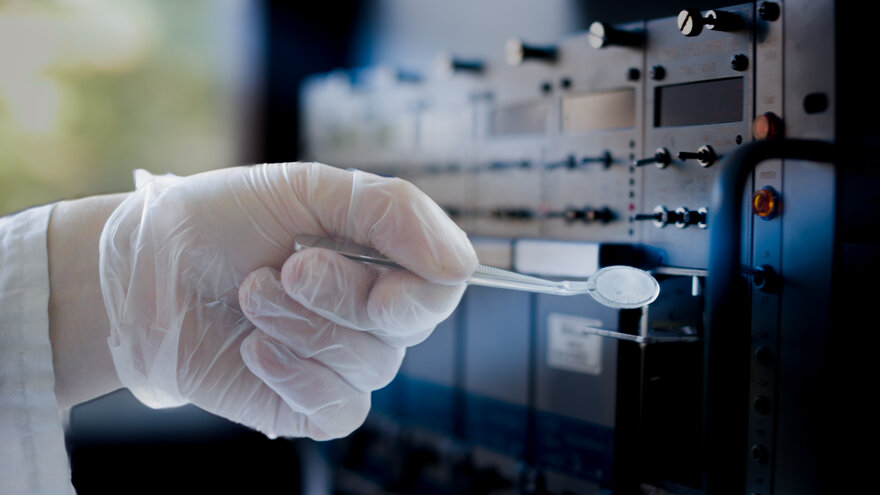Almost three years ago, Aleksander Sverdrup Aarsand completed a master's degree in chemistry and biotechnology at NMBU. Now, he's back as a researcher in a large international research project examining radioactive substances in water.
Aleksander Sverdrup Aarsand carries a large plastic jug in one hand and a small suitcase in the other. He walks down a forest path he has traversed several times before. Despite the sun shining from a blue sky, the wind is bitterly cold. He is on his way to a well with occurrences of radioactive substances, intending to collect samples for later analysis in the lab.
Radon and other naturally occurring radioactive substances are a constant source of concern in society, particularly regarding the risk of cancer.
In the national budget, funds were allocated to NMBU for 20 new study positions in nuclear science, aiming to meet Norway's future competence needs.
Aarsand lifts the heavy well cover, jumps into the well, and opens the suitcase. Among other things, he has electrodes for pH and conductivity measurements, as well as a funnel, syringe, and tubes for collecting samples for lab analysis. He fills the large ten-liter jug with well water for polonium analysis.

Researcher, bass guitarist, and father
An hour later, we are back on campus and inside the lab. For Aarsand, returning to NMBU was a bit like coming home. He has many fond memories from his student days. As a student, he played bass guitar in the university big band in his free time, a hobby he hopes to resume eventually.
Currently, he combines his research career with life as a father of a young child, and his daughter Vera occupies most of his free time.
The contrast to the role of a father is significant as he stands handling corrosive chemicals in the laboratory.
Samples show the presence of natural radioactivity
He ensures that the gloves fit well before bringing out concentrated hydrochloric acid and ammonia. In short, hydrochloric acid and ammonia are added to extract iron hydroxide and polonium, which are eventually deposited on a nickel disk.
"The interesting thing about this method is that 10 liters of water end up being deposited on a nickel disk the size of a twenty-pence coin," says Aarsand enthusiastically, smiling.
Out in the forest the radon sampling was done with a syringe and funnel to minimize air contact with the water, and transferred to a sample bottle with organic counting liquid. Aarsand shook the sample bottle to extract radon from the water into the counting liquid. Back in the laboratory, he places the bottle in an instrument and starts the analysis.
The samples show the presence of natural radioactivity as well as other metals and water properties.
"If we want to know how dangerous radon is, we need to know both the conditions that lead to high radon concentrations and whether radon occurs together with other harmful substances like polonium".
Aleksander Sverdrup Aarsand
We still know little about the significance of radioactive substances in water.
For about a year, Aarsand has been part of RadoNorm, a large international research project on radon and natural radioactive substances. He focuses on the occurrence of radioactive substances in water.
"We still know little about the significance of some radioactive substances in water. It's exciting to contribute to increasing the level of knowledge about this."
Aleksander Sverdrup Aarsand
He is frequently in his hometown Hardanger to take field samples, an area where radon is a known issue.
The number of consumers with radioactive substances in their drinking water is uncertain. We know that the occurrence is frequent, and local variations are significant.
"Households can have their own drinking water sources, so we know little about what may actually be found around the country. In some areas, radon is a known problem, but local variations are significant, and consumers lack awareness," says Aarsand.
Radon in water is not as closely monitored by wastewater treatment plants as, for example, E. Coli, and we still know little about its health effects.
"Radon is a gas, so even if it is dissolved in water, it tends to evaporate into the air. If you have a lot of radon in the water and turn on the shower, you will have a high concentration of radon in the air too," he explains.

Glad he chose chemistry and biotechnology
After working in pharmaceutical quality control for a few years, curiosity led him back to academia. An inherent curiosity and a need to understand and delve into complex issues make the role of a researcher a natural fit for him.
Aarsand decided early on that he wanted to work with the natural sciences. He has never regretted the choice of degree.
"Chemistry and biotechnology are interdisciplinary engineering studies that include natural sciences, physics, and biology in addition to math and law. I'm very glad this was the degree I ended up with," says Aarsand.
Radon levels higher than recommended
Findings from drinking water samples taken in Norway in the 90s showed radon levels many times higher than recommended. While regulations set a limit of 100 Bq/L, values up to 31900 Bq/L were found this time. Banks et. al. (1998) The chemistry of Norwegian groundwaters: I. The distribution of radon, major and minor elements in 1604 crystalline bedrock groundwaters.


